Wedding procession in ancient Telangana..
Annavaram Srinivas
Annavaram Srinivas is a distinctive presence in the expanse and tangle of contemporary Indian art. Beginning with representational works marked by captivating draughtsmanship, he has moved on to an abstract style anchored in native themes expressed through a play of codified motifs.
Born in 1969, in Potharam village (district of karimnagar) in the Indian state of Telangana, Srinivas belongs to a family involved in crafts and art since generations.
His formal education, culminated in an M.Sc, degree in life sciences.
His journey as an artist has been driven by an urge to capture the landscapes, lives and history of the region from where he hails. It is a part of the Deccan Plateau, regarded as semi arid tropics. It is a terrain of flat lands punctuated by rocky hillocks and seasonal streams.
The apparent barrenness of the region holds many marvelous passages of Indian history evident in the ruins of forts, palaces and places of worship renowned for their architecture and stone carvings. The socio-political history of the region too is an intricate tapestry of conflicts, feudal oppression and subaltern cultural expressions.
An overriding weave across the cultural heritage of the region is a reverential approach to all of nature.
Srinivas has arduously searched for and found a singular idiom to engage with his provenance. His acrylic on canvas works have drawn inspiration from Australian aboriginal art in terms of a codification of abstract patterns to represent his native landscapes, life, conflicts and the intersection of past and present. The craft finds enigmatically enticing resonances with a consistent syllabary of iconic elements. They echo his training in life sciences. For instance are patterns that evoke sub-cellular organelles.
Srinivas’s paintings are discourses and narratives employing an ensemble of ordered abstract patterns. The colours have a definitive insistence.
-Ajithan G Kurup.
--------------
What
the bird saw
Rectangular farm
plots, rounded clusters of village habitation, lakes, and ponds in fiery red
circles.
-------------------
What the child saw
Lying on his back in the courtyard the
child gazes up at the wonders of the sky… the milky way, distant galaxies and
vague swirls of cosmic matte
----------------
Inheritance
A symbolic
representation of the pasts fingerprints… a tribute to the struggles of our forbears
and the inheritance of culture and tradition they left us.
--------------
Dialectics 3
A motif on the
play of continuity and change across the sands of time.
-----------
Cloud cheer
Rain clouds over
the Deccan make the earth waken in anticipation and bring a festive gladness to
the people. Billowing clouds hover above and silvery streams of rain are soaked
up by the lake and the hillocks around it.
--------------
Wind watching
The summer of the
Deccan, turn cool suddenly with cross currents of winds announcing the arrival
of the southwest monsoon. It is a time when you can almost see the wind!
----------------
Summer’s
daybreak
The
dawn is always a symbol of hope and renewal. Through a summer in the Deccan, it
can also be an ambiguous play of energies. The heat waves are palpable and the
lakes and ponds are both warmed and thirst for refreshment
--------------
Crop
Circles I An
abstract representation of a strange phenomenon.
--------------
Parched earth
The yellow curves
represent dry riverbeds over looked by bald hillocks in red semicircles. The
only moisture around in the light flow of water along the canal depicted flat
red. The crimson circle is pond that still holds a ripple of water. A few
villages are scattered across what seems like a wasteland. The patch of green
plains is hammed by dry lands with thorn bushes. A depiction of a landscape
turned unnatural by dying rivers.
-------------
The road to the city
From the bottom portion, representing a forest, the black line of a
highway traverses the brown of the mixing belt, a stretch of farmlands, a sub
urban industrial area in brown and then the populous city. The red circles are
water bodies.
--------------
Urban tentacles
The tumults of red lines are roads to the cities engulfing outlying sub
urban and villages. Rectangles are where realty business is flourishing and
green patches where farming will soon give way to construction. Yellow ovals
are urban concentration and the red circle a lake that is struggling to
survive.
-------------
Crop Circles 2 The urban legend
of ‘Crop circles’ stirs the imagination to cosmic abstractions.
--------------
A town in two minds
A little town (the brown circle) falls across large stretches of green
meadows and barren lands. The black line of a road appears to divide the town
and the landscape too. The motif of the barren stretch (in white and black
lines) is eddying summer winds. The crimson circles are water sources.
-------------
Before the picking
The Deccan is known for its black cotton soil. Cotton fields ready for
picking are a stirring sight, with the day, black earth, browning stalks and
leaves, and the explosive white of the cotton pods. Big grey circular shapes
are habitations; crimson circles well and bore wells, small grey circles trees
and the black thin lines stream.
---------------
Invocations in yellow
In rural Telangana of the Deccan, some communities perform the Mallanna patnalu ritual (patnalu meaning patterns made of
yellow turmeric). These rituals with tantric overtones last seven days. The
complex patterns are done from memory by the folk priest on a sanctified floor.
The ritual invokes the fold god Mallanna.
--------------
Sankranthi
The sun is
aligning with the zodiac sign of Capricorn. Winter chills is giving way to warm
days. In celebration, house interiors are white washed and their outer walls
coated over with earth the colours of burnt sienna and striped with white wash.
This is a task of women and young girls. The symbolisms of Sankranthi are
similar to that of spring festivals elsewhere.
--------------
Rural royalty
The homes of rural landlords stand out even today. This is an abstract
representation of a wedding at a rural ‘manor’. From the top right, clockwise
to the entrance, is the hall with stately wooden pillars. In her room, the
bride is being readied for the wedding. Above that, in another part relatives
are discussing and dining, vertical blocks on the left are expensive rooms,
storehouses, guest quarters etc. In the centre is a courtyard garden with trees
and a fountain. Along the bottom and right edge are the roads to the homestead
and its main entrance.
----------------
Scared Union
An abstract
representation of a rural Hindu wedding in the Deccan. Towards the centre is a
rectangular space where the bride and groom are seated facing each other. Other
elements include habitations and pathways as well as decorative patterns
marking the festivities. To the bottom is a representation of the two serpents,
powerful symbols that are elements of decorative patterns associated with
wedding celebrations.
----------------
And the earth shuddered
A metaphoric
schema of strokes and colours about mining for metals and minerals. Open cast
mines, with them gory appearance, dust laden transportation paths, and hectic
activities of mine workers are all woven into this dramatic representation.
--------------
Global theatre
No landscape is
untouched by the challenges and opportunities of the global village. This is an
abstraction of the underlying conflicts searching for resolution.
---------------
Swirls and eddies
In every moment of
history, the seeing eye discerns the deep play of similar and opposing forces
reconcile and transform into fresh storms that underlies human evolution.
--------------
The sacred river
The Godavari is
one of the holy rivers of India at whose banks the faithful gather for rituals,
ceremonies and festivals. The curling and winding crimson represents the
restless flow of the river Godavari. Yellow oval shapes are tribal habitation. Hills,
trees, and people grazing livestock add to this celebration of the godavari at
Polavaram.
--------------
Global theatre
No landscape is
untouched by the challenges and opportunities of the global village. This is an
abstraction of the underlying conflicts searching for resolution.
--------------
The Shandy
Shandies are weekly markets close to small
towns where neighboring villagers bring their produce and products to sell and
also shop for everything from pots and pans to bangles and toilet soap. In the centre
is the shandy yard with its shops and crowds. It is just outside the town
represented in top left in a red oval webbed in grey. Yet top left in a oval
webbed in grey. Yet another town is represented at the bottom. The shandy gets
its life from the villages represented in circular greens. Paths crisscross the
landscape with red circles showing ponds. Rectangular shape represents farms
and ‘u’ shapes within them people at work.
______
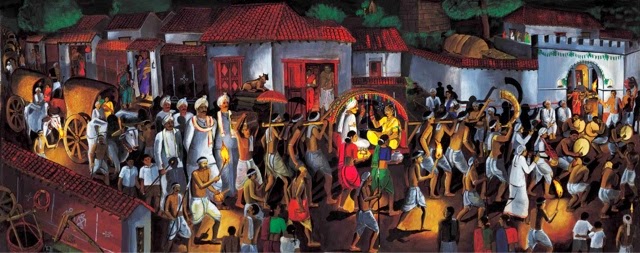



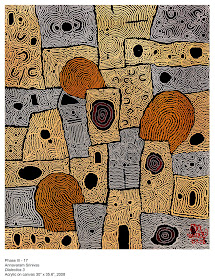


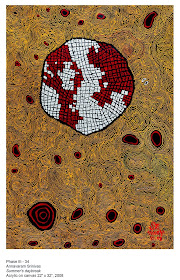

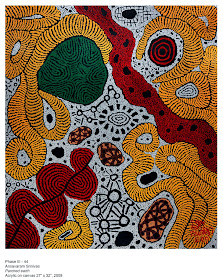

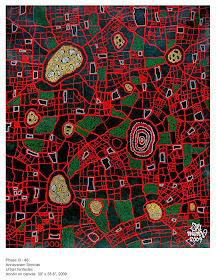

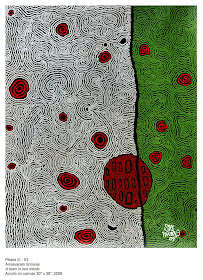






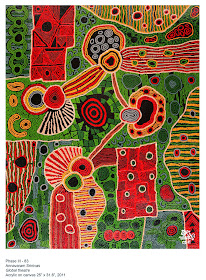
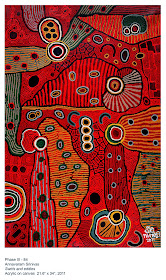


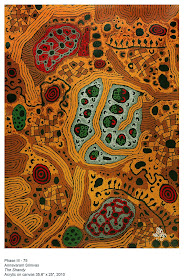
No comments:
Post a Comment